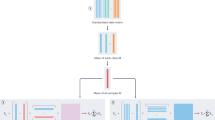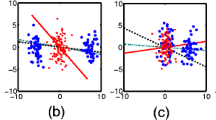Abstract
Linear discriminant analysis (LDA) is one of the most popular supervised dimensionality reduction (DR) techniques and obtains discriminant projections by maximizing the ratio of average-case between-class scatter to average-case within-class scatter. Two recent discriminant analysis algorithms (DAS), minimal distance maximization (MDM) and worst-case LDA (WLDA), get projections by optimizing worst-case scatters. In this paper, we develop a new LDA framework called LDA with worst between-class separation and average within-class compactness (WSAC) by maximizing the ratio of worst-case between-class scatter to average-case within-class scatter. This can be achieved by relaxing the trace ratio optimization to a distance metric learning problem. Comparative experiments demonstrate its effectiveness. In addition, DA counterparts using the local geometry of data and the kernel trick can likewise be embedded into our framework and be solved in the same way.
Similar content being viewed by others
References
Fukunaga K. Statistical Pattern Recognition. Academic Press, 1990
Duda R. Hart P. Stork D. Pattern Classification. 2nd ed. New York: John Wiley & Sons, Inc., 2001
Yang B. Chen S. Wu X. A structurally motivated framework for discriminant analysis. Pattern Analysis and Application, 2011, 14(4): 349–367
Jae H. Nojun K. Generalization of linear discriminant analysis using Lp-norm. Pattern Recognition Letters, 2013, 34(6): 679–685
Ching W. Chu D. Liao L. Wang X. Regularized orthogonal linear discriminant analysis. Pattern Recognition, 2012, 45(7): 2719–2732
Li H. Jiang T. Zhang K. Efficient and robust feature extraction by maximum margin criterion. IEEE Transaction on Neural Networks, 2006, 17(1): 157–165
Nenadic Z. Information discriminant analysis: feature extraction with an information-theoretic objective. IEEE Transactions on Pattern Analysis and Machine Intelligence, 2007, 29(8): 1394–1407
Zhu M. Martinez A. Subclass discriminant analysis. IEEE Transactions on Pattern Analysis andMachine Intelligence, 2006, 28(8): 1274–1286
Gao Q. Liu J. Zhang H. Hou J. Yang X. Enhanced fisher discriminant criterion for image recognition. Pattern Recognition, 2012, 45(10): 3717–3724
Cai D. He X. Kun Z. Han J. Bao H. Local sensitive discriminant analysis. In Proceedings of the international joint conference on artificial intelligence. 2007, 141–146
Fan Z. Xu Y. Zhang D. Local linear discriminant analysis framework using sample neighbors. IEEE Transaction on Neural Networks, 2011, 22(7): 1119–1132
Xu B. Huang K. Liu C. Dimensionality reduction by minimal distance maximization. In: Proceedings of 20th International Conference on Pattern Recognition, 2010, 569–572
Zhang Y. Yeung D. Worst-case linear discriminant analysis. In: Proceedings of Advances in Neural Information Processing Systems. 2010, 2568–2576
Ying Y. Li P. Distance metric learning with eigenvalue optimization. Journal of Machine Learning Research, 2012, 13: 1–26
Overton M. Womersley R. Optimality conditions and duality theory for minimizing sums of the largest eigenvalues of symmetric matrices. Math Programming, 1993, 62(2): 321–357
Overton M. On minimizing the maximum eigenvalue of a symmetric matrix. SIAM Journal on Matrix Analysis and Applications, 1988, 9(2): 256–268
Zhang Y. Yeung D. Semi-supervised generalized discriminant analysis. IEEE Transactions on Neural Network, 2011, 22(8): 1207–1217
Mika S. Ratsch G. Weston J. Scholkopf B. Smola A. Muller K. Constructing descriptive and discriminative nonlinear features: Rayleigh coefficients in kernel feature spaces. IEEE Transactions on Pattern Analysis and Machine Intelligence, 2003, 25(5): 623–628
Duin R. Loog M. Linear dimensionality reduction via a heteroscedastic extension of LDA: the Chernoff criterion. IEEE Transactions on Pattern Analysis and Machine Intelligence, 2004, 26(6): 732–739
Frank A. Asuncion A. UCI Machine Learning Repository. http://archive.ics.uci.edu/ml
Belhumeur P. Hespanha J. Kriegman D. Eigenfaces vs fisherfaces: recognition using class specific linear projection. IEEE Transactions on Pattern Analysis and Machine Intelligence, 1997, 19(7): 711–720
Martinez A. Benavente R. The AR-face database. Technical Report 24, CVC, 1998. http://www2.ece.ohiostate.edu/?aleix/ARdatabase.html
Nene S. Nayar S. Murase H. Columbia Object Image Library (COIL-20). Technical Report005, CUCS, 1996. http://www1.cs.columbia.edu/CAVE/software/softlib/coil-20.php
Author information
Authors and Affiliations
Corresponding author
Additional information
Leilei Yang received his BS degree in computer science and technology from Nanjing University of Aeronautics & Astronautics (NUAA) in 2011. Since September 2011, he began his MS degree in computer applications at NUAA. His research interests include pattern recognition, machine learning and neural computing.
Songcan Chen received his BS degree in mathematics from Hangzhou University (now merged into Zhejiang University) in 1983. In December 1985, he completed his MS degree in computer applications at Shanghai Jiaotong University and then worked at the Nanjing University of Aeronautics & Astronautics (NUAA) in January 1986 as an assistant lecturer. Since 1998, as a full-time professor, he has been with the College of Computer Science and Technology at NUAA. His research interests include pattern recognition, machine learning and neural computing.
Rights and permissions
About this article
Cite this article
Yang, L., Chen, S. Linear discriminant analysis with worst between-class separation and average within-class compactness. Front. Comput. Sci. 8, 785–792 (2014). https://doi.org/10.1007/s11704-014-3337-x
Received:
Accepted:
Published:
Issue Date:
DOI: https://doi.org/10.1007/s11704-014-3337-x




